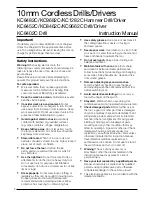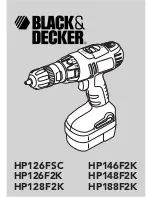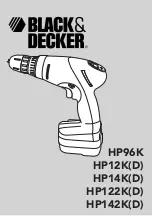
10
WARNING:
Always remove battery pack from your tool when you are
assembling parts, making adjustments, cleaning, or when
not in use. Removing battery pack will prevent accidental
starting that could cause serious personal injury.
REMOVING THE BATTERY PACK
See Figure 4, page 14.
Locate the latches on the side of the battery pack and
depress them to release the battery pack from the saw.
Remove battery pack from the saw.
WARNING:
Battery tools are always in operating condition. There-
fore, switch should always be locked when not in use or
carrying at your side.
KICKBACK
See Figures 5 - 8, pages 14 - 15.
Kickback occurs when the blade stalls rapidly and the saw
is driven back towards you. Blade stalling is caused by any
action which pinches the blade in the wood.
DANGER:
Release switch immediately if blade binds or saw stalls.
Kickback could cause you to lose control of the saw. Loss
of control can lead to serious injury.
To guard against kickback, avoid dangerous practices such
as the following:
Setting blade depth incorrectly.
Sawing into knots or nails in workpiece.
Twisting the blade while making a cut.
Making a cut with a dull, gummed up, or improperly set
blade.
Supporting the workpiece incorrectly.
Forcing a cut.
Cutting warped or wet lumber.
Operating the tool incorrectly or misusing the tool.
To lessen the chance of kickback, follow these safety
practices:
Keep the blade at the correct depth setting. The depth
setting should not exceed 1/4 in. below the material being
cut.
Inspect the workpiece for knots or nails before cutting.
Never saw into a knot or nail.
Make straight cuts. Always use a straight edge guide
when rip cutting. This helps prevent twisting the blade.
Use clean, sharp, and properly set blades. Never make
cuts with dull blades.
OPERATION
Support the workpiece properly before beginning a cut.
Use steady, even pressure when making a cut. Never
force a cut.
Do not cut warped or wet lumber.
Hold the saw firmly with both hands and keep your body
in a balanced position so as to resist the forces if kickback
should occur.
WARNING:
When using the saw, always stay alert and exercise con-
trol. Do not remove the saw from the workpiece while the
blade is moving.
SAW BLADES
The best of saw blades will not cut efficiently if they are not
kept clean, sharp, and properly set. Using a dull blade will
place a heavy load on the saw and increase the danger of
kickback. Keep extra blades on hand, so that sharp blades
are always available.
Gum and wood pitch hardened on blades will slow the saw
down. Remove saw blade from the saw and use gum and
pitch remover, hot water, or kerosene to remove these ac-
cumulations.
DO NOT USE GASOLINE.
BLADE GUARD SYSTEM
See Figure 9, page 15.
The lower blade guard attached to your circular saw is there
for your protection and safety. Do not alter it for any reason.
If it becomes damaged, do not operate the saw until you
have the guard repaired or replaced. Always leave guard in
operating position when using the saw.
DANGER:
When sawing through work, lower blade guard does not
cover blade on the underside of work. Since blade is
exposed on underside of work, keep hands and fingers
away from cutting area. Any part of your body coming in
contact with moving blade will result in serious injury.
CAUTION:
Never use saw when guard is not operating correctly.
Check the guard for correct operation before each use.
The guard is operating correctly when it moves freely and
readily returns to the closed position. If you drop the saw,
check the lower blade guard and bumper for damage at
all depth settings before reuse.
STARTING/STOPPING THE SAW
See Figure 10, page 15.
To start the saw: Depress the switch trigger.
Always let the blade reach full speed, then guide the saw
into the workpiece.
Содержание P824
Страница 38: ...14 Espa ol NOTAS...
Страница 39: ...15 Espa ol NOTAS...
Страница 40: ...16 Espa ol NOTAS...











































